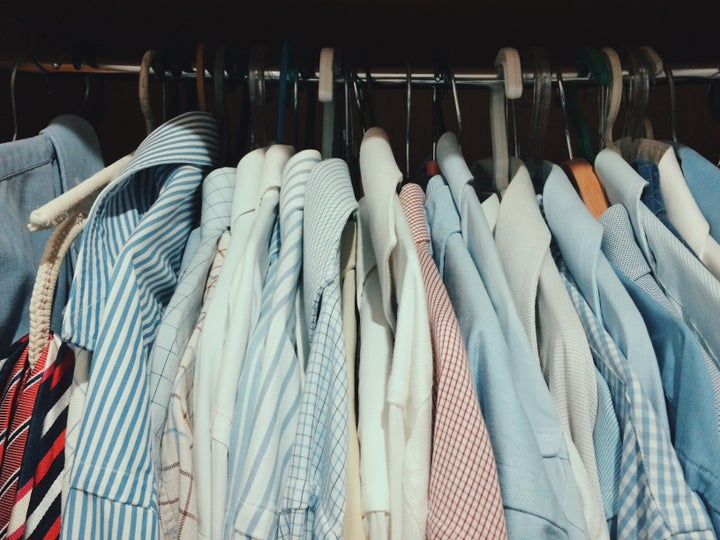This article is part of HuffPost’s “Reclaim” campaign, an ongoing project spotlighting the world’s waste crisis and how we can begin to solve it.
Between ignoring your clothing’s laundry symbols and washing your underwear incorrectly, there are plenty of ways you might be shortening the lifespan of your clothes. And in a country where each one of us throws out approximately 70 pounds of textiles every year, it’s important that we all do what we can to reduce our amount of fashion waste.
Using the proper washing techniques is one of the most effective ways to keep your clothes in the best shape, but there’s one other factor that plays a role, and you might be ignoring it. It’s all in how you store your clothes.
According to professional organizers Ann Sullivan (founder of Ann Sullivan Organizing in New York City) and Mindy Godding (co-owner of Abundance Organizing in Richmond, Virginia), keeping your clothes organized the right way will go far to keep them in good shape.
Mistake #1: You’re probably using the wrong hangers.
“People will spend so much money on clothes and still use crappy hangers,” Sullivan told HuffPost. She explained that there is a hanger for every purpose and that your clothes will thank you for using the correct hanger.
“Investing in hangers should be a top priority,” Sullivan said. For example, use flat, thin hangers, which are really good for someone who doesn’t have a lot of space ― “really good for dresses and blouses that don’t need a lot of space between them” ― and wide-shoulder hangers for suits, which support the shoulders in men’s suit jackets. “The right size hanger and style are very important,” she said.
Godding, an “evangelist about matching hangers,” emphasized that it’s important to find a hanger system that works for you and to keep it uniform ― find a type of hanger that works for your blouses, for example, and use that same type for all of the blouses in your wardrobe. “I’ve seen so many clients take more care of their clothing if it has that nice, clean look when they open the door. Something about it that gives us more accountability to our stuff.”

Mistake #2: You’re stuffing your closet.
If you’re like most people, you don’t have a dreamy Carrie Bradshaw walk-in closet. But stuffing all your clothes together in a tight space can wear them out faster. When your clothes are pressed against each other, you can get creases down your clothing, “so you want them free and clear,” Godding advised, “maintaining the integrity of the fabric.”
What is ideal space between hangers? A quarter of an inch of space on each side is best, Godding said. “Another good tip is if you can slide the hangers back and forth with ease, you’re good, but if you have to get in there and shove the neck of the hanger over, it’s a good indication that it’s overstuffed.”
Mistake #3: You’re hanging up your sweaters.
Sweaters shouldn’t be hung on a hanger as you would a shirt, because “the weight of the garment will expand and stretch out the shoulders,” Godding said. She’ll fold them in half, pull the sleeves in, and drape them over the bottom rung of a hanger, “as if a pair of pants.”
You can also fold the sweater around the top of the hanger.
Mistake #4: You’re putting everything on hangers.
Socks, bras, athletic wear ― these should be kept in your dresser, folded neatly, and where bras are concerned, organized so that their forms aren’t impacted. “Everybody needs both hanging storage and folded storage,” Godding said, “whether a dresser, drawer basket or bins within your wardrobe space. Bins would be best for undergarments, swimsuits, athletic wear which can go folded down.”
And with bras, “as long as they’re uniformly folded in the same way, they’ll stack neatly in a drawer... Stuffing them all in a drawer is not the way to go.”

Mistake #5: You’re not taking care of your out-of-season clothes.
Clothes we don’t wear year round, such as sweaters and coats during the summer, or our linen shirts and swimsuits during the winter ― should be stored correctly, in clear, airtight bins. “I loosely roll and pack things, because you don’t want creases, which are hard to get out. Imagine something that is folded for nine months,” Sullivan said. “It impacts the integrity of the fabric. I always unfold it and there are little, yellowed lines.”
For things like summer dresses and delicate items, Sullivan says you shouldn’t fold them, and instead keep them in breathable cotton garment bags in a cool, dark place.
Mistake #6: You’re dry cleaning too often.
“Dry cleaning shortens the lifespan of clothes,” Sullivan said, adding that in most cases, for heavier clothes, all you need is a clothing brush: hang it on a valet rod and, using a thick-bristled clothing brush, brush the dust, dirt and food out of your suit for a few minutes. “You’ll have fewer trips to the dry cleaner and it’s better for your clothes.”
Mistake #7: You’re keeping your clothes in dry cleaning bags.
You know those plastic bags your dry cleaning comes in? You’ll need to get rid of those as soon as you get your dry cleaning home. “Dry cleaning is a misnomer, because when the garments are pressed, there’s still steam involved; there’s a little bit of moisture in the clothes,” Sullivan said. “You don’t want to seal it in a plastic bag, you want to [take it out and] let it breathe.”